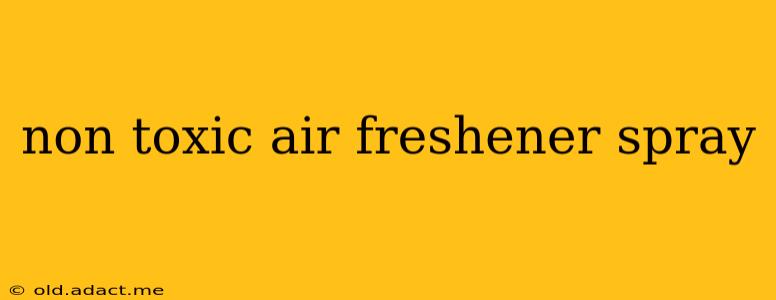Are you tired of harsh chemical air fresheners that leave you with headaches and a lingering artificial scent? You're not alone! Many people are seeking safer, more natural alternatives to freshen their homes. This guide explores the world of non-toxic air freshener sprays, offering insights into effective DIY solutions and commercially available options. We'll also address common concerns and questions surrounding these products.
What Makes an Air Freshener "Non-Toxic"?
Before we delve into specific products and recipes, it's crucial to understand what constitutes a truly non-toxic air freshener. A non-toxic air freshener avoids volatile organic compounds (VOCs), phthalates, parabens, and other potentially harmful chemicals commonly found in conventional sprays. These chemicals can irritate the respiratory system, trigger allergies, and even have long-term health consequences. Instead, non-toxic options rely on natural essential oils and other plant-based ingredients.
DIY Non-Toxic Air Freshener Spray Recipes
Creating your own non-toxic air freshener is surprisingly easy and allows for complete control over the ingredients. Here are a couple of popular recipes:
Recipe 1: Simple Citrus Freshener
- 1 cup distilled water
- 15-20 drops of citrus essential oils (lemon, orange, grapefruit – choose your favorite!)
- Optional: 1 teaspoon vodka (acts as a preservative)
Instructions: Combine all ingredients in a spray bottle. Shake well before each use.
Recipe 2: Lavender and Rosemary Calming Spray
- 1 cup distilled water
- 10 drops lavender essential oil
- 5 drops rosemary essential oil
- Optional: 1 teaspoon witch hazel (acts as a preservative)
Instructions: Combine all ingredients in a spray bottle. Shake well before each use.
Where to Buy Non-Toxic Air Fresheners?
If DIY isn't your thing, many companies offer commercially available non-toxic air fresheners. Look for products that clearly list their ingredients and are certified by organizations like the Environmental Working Group (EWG). Always check the label for potential allergens or irritants.
Are Essential Oils Safe for Everyone?
While generally considered safe when diluted properly, essential oils can cause allergic reactions in some individuals. Always perform a patch test before using a new essential oil blend, especially if you have sensitive skin or respiratory issues. If you experience any adverse reactions, discontinue use immediately.
What About Air Purifiers? Are They a Good Alternative?
Air purifiers offer a different approach to improving indoor air quality. While they don't necessarily freshen the air with a pleasant scent, they actively remove pollutants, dust, and other particles that can negatively impact air quality and contribute to odors. Air purifiers can be a valuable complement to non-toxic air fresheners.
How Often Should I Spray a Non-Toxic Air Freshener?
The frequency of spraying depends on your preference and the strength of your chosen scent. Start with a few sprays in each room and adjust as needed. Over-spraying can be just as unpleasant as using a harsh chemical spray.
Can I Use Baking Soda to Eliminate Odors?
Yes! Baking soda is a natural odor absorber. Place open containers of baking soda in areas prone to odors, such as refrigerators or pet areas. It effectively neutralizes unpleasant smells without adding any artificial fragrance.
What are the benefits of using a non-toxic air freshener?
The benefits are numerous: a healthier home environment, reduced risk of respiratory irritation and allergies, avoidance of harsh chemicals, and the enjoyment of pleasant, natural scents.
This guide provides a starting point for your journey towards a fresher, healthier home using non-toxic air fresheners. Remember to always prioritize your health and well-being when choosing household products.
